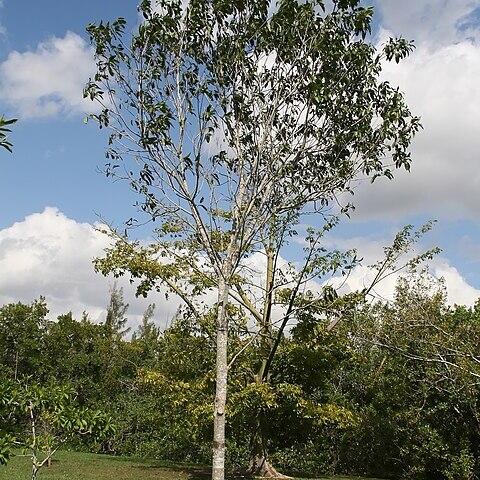Trees, to 25 m . Stems not armed, glabrous. Leaves deciduous; petiole 14-51 mm, glabrous; blade (yellow-green abaxially, lustrous dark green adaxially), elliptic to oblanceolate, 51-117 × 23-63 mm, base rounded, obtuse, or acute, margins slightly involute, undulate, apex rounded to obtuse, surfaces glabrous; venation visible, midrib sunken, marginal vein present. Inflorescences 6-12-flowered. Pedicels 4-10 mm, glabrous. Flowers: calyx 4-5 mm diam.; sepals 5, 1.7-1.9 × 1.2-1.7 mm, glabrous abaxially; petals 5, yellow, median segment elliptic to ovate, 1.8-2.5 mm, (lobed basally), lateral segments vestigial or absent; stamens 5-6, 2.8-3.9 mm; staminodes lanceolate, 1-2 mm, erose or toothed; anthers lanceolate, 1.3-1.7 mm; pistil (4-)5(-6)-carpellate; ovary (4-)5(-6)-locular, 1.2-1.4 mm, glabrous; style 1.4-2 mm. Berries yellow to orange, ellipsoid, [15-]17-21[-26] mm, glabrous. Seeds 13-20 mm.
More
An evergreen tree. It grows up to 25 m tall. The leaves are simple and yellowish-green. They are oblong and 20 cm long. The flowers are small and creamy-yellow. They clasp the twigs. They have a smell like cheese. The fruit is fleshy with a stone. They are 2.5 cm across. They are deep yellow and sour. They have a gummy latex.
A tropical plant. It is native to Central America and the West Indies. It grows in dry coastal forests and woodlands. It can tolerate drought and salt. It need full sun and does best in a fertile, well drained soil. It suits hardiness zones 9-11.
More
Coastal and moist limestone forests in Puerto Rico.


